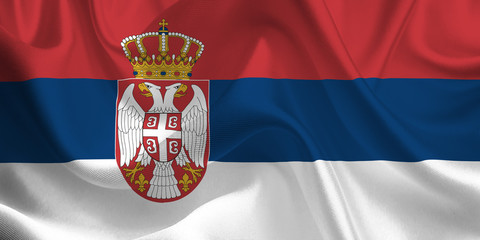
On 7 November 2007, Serbia initiated a Stabilisation and Association Agreement (SAA) with the European Union. The SAA came into force on 1 September 2013.
Despite the multidimensional crisis that lasts almost 3 years, Serbia has managed to preserve the stability of its economy and the consumers and investors’ confidence, as evidenced by cumulative real GDP growth in the period 2020-2022 of around 9%, record inflows of FDI, as well as a record level of FX reserves. According to National bank of Serbia, projected growth rate of Serbia’s GDP for this year at 2.0-3.0%. Projected GDP growth for 2024 ranges from 3% to 4%, and in the medium-term National Bank of Serbia expects a return to pre-crisis growth rates of 4%. Current CAD projections in 2023 is EUR 3.1 bn (4.5% of GDP). Owing to product and geographic diversification and export-oriented investments, goods, and services exports in 2022 increased by more than 30%, while the y/y growth in Q1 2023 was around 20%. In March 2023 public debt of central government stood at the level of 51.0% of GDP. In May, the NBS kept the key policy rate at 6.0% as the full-fledged effects of past monetary measures should be considered in conditions of gradual weakening of cost-push pressures from the international environment and easing of disruptions to global supply chains. Banking sector stability has been preserved and further reinforced. The share of NPLs stood at 3.00% in March 2023. [1]
According to National Employment Agency, the unemployment rate in 2022 was 9.4%, which is the lowest recorded level to date. Formal employment continued to grow at the beginning of 2023 (2.9% y/y in the period January-March). Despite continued growth of employment and wages in the private sector, Serbia is still considered a country that offers a wide availability with a unique combination of high quality and low costs Serbian workforce, with an average gross monthly salary RSD 117.669 (approx. EUR 1.000[2]) Current gross minimal salary is RSD 57.274 (approx. EUR 490). For young people the Serbian labour market is still characterized by low employment and activity rates. Without sufficient development and financial perspective, highly qualified Serbian citizens, possessing excellent knowledge and technical skills, tend to look towards other countries (mainly EU Member States) for employment opportunities.
The labour supply in Serbia annually increases by approximately 35,000 universities and colleges’ graduates, 1,000 Masters of Science, 400 PhDs and 75,000 high school graduates. Educational centres in Serbia (Belgrade, Nis, Novi Sad, Kragujevac…), especially University of Belgrade (Serbian university highly positioned on ranking lists that compare universities all around the word), boast a well-educated, multilingual and IT-literate labour force. Management education has also been improved by the introduction of joint graduate and post-graduate courses organized by local universities and renowned Western business schools.
With an estimated 49% of the working population speaking English, Serbia is ranked 1st in the SEE region.
[1] Source: National Bank of Serbia (May 2023)
[2] Source: Statistical Office of the Republic of Serbia (May 2023)
Source: Development Agency of Serbia (2020)
To facilitate decision about where to invest in Serbia, we are presenting latest available info about number of inhabitants and average gross salary (EUR) per districts in Serbia, according to Statistical Office of the Republic of Serbia (December 2023).
|
District in Serbia |
City |
Number of inhabitants |
|
1. Beogradska district |
Belgrade |
1,658,151 |
|
2. Južnobačka district |
Novi Sad |
615,190 |
|
3. Nišavska district |
Nis |
376,522 |
|
4. Sremska district |
|
312,530 |
|
5. Raška district |
|
308,927 |
|
6. Mačvanska district |
|
299,345 |
|
7. Južnobanatska district |
|
294,043 |
|
8. Šumadijska district |
|
293,422 |
|
9. Zlatiborska district |
|
286,825 |
|
10. Rasinska district |
|
242,300 |
|
11. Jablanička district |
|
216,583 |
|
12. Pomoravska district |
|
214,872 |
|
13. Moravička district |
|
212,752 |
|
14. Pčinjska district |
|
203,391 |
|
15. Podunavska district |
|
199,497 |
|
16. Zapadnobačka district |
|
188,447 |
|
17. Srednjobanatska district |
|
187,860 |
|
18. Severnobačka district |
|
186,985 |
|
19. Braničevska district |
|
183,860 |
|
20. Kolubarska district |
|
174,760 |
|
21. Severnobanatska district |
|
147,890 |
|
22. Borska district |
|
125,285 |
|
23. Zaječarska district |
|
120,216 |
|
24. Pirotska district |
|
92,614 |
|
25. Toplička district |
|
91,832 |
Table 1: Number of inhabitants per district
|
District in Serbia |
City |
|
|
1. Beogradska district |
Belgrade |
1,433.96 |
|
2. Južnobačka district |
Novi Sad |
1,181.22 |
|
3. Borska district |
|
1,071.19 |
|
4. Južnobanatska district |
1,038.24 |
|
|
5. Sremska district |
|
1,007.18 |
|
6. Severnobačka district |
|
998.85 |
|
7. Nišavska district |
Nis |
992.24 |
|
8. Šumadijska district |
|
989.86 |
|
9. Moravička district |
|
973.53 |
|
10. Srednjobanatska district |
|
965.74 |
|
11. Podunavska district |
|
951.70 |
|
12. Kolubarska district |
|
940.67 |
|
13. Braničevska district |
|
939.62 |
|
14. Zlatiborska district |
|
914.64 |
|
15. Rasinska district |
|
912.40 |
|
16. Pirotska district |
|
910.60 |
|
17. Severnobanatska district |
|
906.54 |
|
18. Zapadnobačka district |
|
902.67 |
|
19. Mačvanska district |
|
901.81 |
|
20. Toplička district |
|
880.89 |
|
21. Zaječarska district |
|
875.37 |
|
22. Pomoravska district |
|
847.74 |
|
23. Raška district |
|
842.18 |
|
24. Pčinjska district |
|
805.56 |
|
25. Jablanička district |
|
787.63 |
Table 2: Average GROSS salary (EUR) per district

